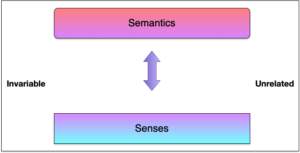I’ve talked before about the power of ritual, but while powerful, it also seemed piecemeal. That is, there were lots of hints, but not a coherent theory. That has now changed. I recently found a paper by Nicholas Hobson & colleagues (Schroeder, Risen, Xylagatas, & Inzlicht; warning, PDF) titled The Psychology of Rituals that creates an integrated framework. And while my take simplifies it down, I found it interesting.
 At core, what the model suggests is that there are two components that are linked together. The first element are things that involve the senses. The second element are the semantics we’re looking to create allegiance and adherence too. And there are important elements about this relationship.
At core, what the model suggests is that there are two components that are linked together. The first element are things that involve the senses. The second element are the semantics we’re looking to create allegiance and adherence too. And there are important elements about this relationship.
There are a number of elements that are on tap for involving the senses. Certain movements, sounds, and words said or to be spoken can be used. There can also be food, drink, smells, and more. Objects also. Timing is an element; at the micro level of things in order, and at the macro level of the triggers for the ritual.
Semantics come, of course, from your needs. It can be about things you want people to believe, or a set of values you want people to subscribe to. Or, of course, both. From the design purpose, I’d suggest it’s about agreeing to be a member of a community of practice; to undertake certain actions when appropriate, and to uphold certain values.
Interestingly, according to their model, the relationship between the two is effectively arbitrary. That is, there is no intrinsic relationship between what you’re signifying, and how you do so. Rituals are about the practices. Which means you could in theory do just about anything to make the relationship.
The other thing is that the ritual has to be invariable in its aspects. You define it, and so do it. Note that the execution can vary considerably; from several times a day to upon certain triggering conditions. So, for instance, having completed a course, or before engaging in certain activities.
While such a definition gives us lots of freedom, it also doesn’t necessarily serve as a guide for design. Still, thinking about it in this way does suggest the utility in developing deeply held beliefs and appropriately practiced behaviors. At least, that’s how I see it. You?
I’ve always thought that there is a lot of crossover between habit and ritual. The order I brush my teeth in. The way I make a cup of coffee. That sort of thing. They’re habits so ingrained that they’ve nearly become ritual; if something interrupts me in the middle of brushing my teeth I almost have to start over, because I do the whole process on such automatic cruise-control that I’m not even consciously aware of where I’m up to, so I have no idea where to re-start.
Which I guess you could harness, in the other direction. Design “rites” to create the habits you want to become subconscious.
I found this content interesting Clark so I shared it as part of a cracker barrel virtual round table.
I presented it a little bit like Rob describes above except differentiated the 4 categories of ritual and focused on what type of performance outcomes/lvl of Bloom’s taxonomy each type of ritual supported.
So we talked about the ways teachers control the classroom, highlight important information (1st lvl of ritual guides attention) — everyone knew what it meant for a teacher to shut the lights, write a word on the board etc… we came up with numerous ways we “short-cut” instructional text based on these “shared practices” we take for granted
The audience’s eyes and body language suggested no one had ever thought about their learning processes as “influenced” by these type of engagement — I hope some young researches focus more on this